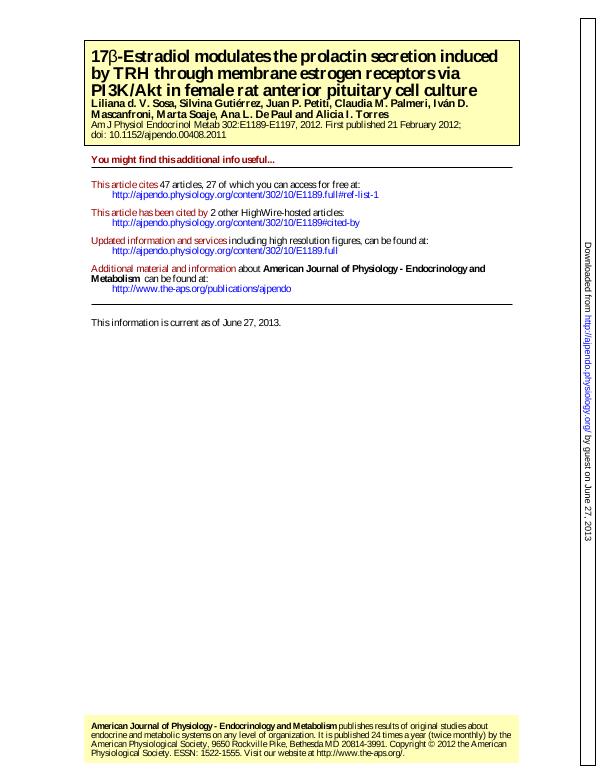Artículo
17β-Estradiol modulates the prolactin secretion induced by TRH through membrane estrogen receptors via PI3K/Akt in female rat anterior pituitary cell culture
Sosa, Liliana del Valle ; Gutiérrez, Silvina
; Gutiérrez, Silvina ; Petiti, Juan Pablo
; Petiti, Juan Pablo ; Palmeri, Claudia Mariela
; Palmeri, Claudia Mariela ; Mascanfroni, Ivan Darío
; Mascanfroni, Ivan Darío ; Soaje, Marta
; Soaje, Marta ; de Paul, Ana Lucia
; de Paul, Ana Lucia ; Torres, Alicia Ines
; Torres, Alicia Ines
 ; Gutiérrez, Silvina
; Gutiérrez, Silvina ; Petiti, Juan Pablo
; Petiti, Juan Pablo ; Palmeri, Claudia Mariela
; Palmeri, Claudia Mariela ; Mascanfroni, Ivan Darío
; Mascanfroni, Ivan Darío ; Soaje, Marta
; Soaje, Marta ; de Paul, Ana Lucia
; de Paul, Ana Lucia ; Torres, Alicia Ines
; Torres, Alicia Ines
Fecha de publicación:
02/2012
Editorial:
American Physiological Society
Revista:
American Journal Of Physiology-endocrinology And Metabolism
ISSN:
1522-1555
e-ISSN:
0193-1849
Idioma:
Inglés
Tipo de recurso:
Artículo publicado
Clasificación temática:
Resumen
Considering that estradiol is a major modulator of prolactin (PRL) secretion, the aim of the present study was to analyze the role of membrane estradiol receptor-α (mERα) in the regulatory effect of this hormone on the PRL secretion induced by thyrotropin-releasing hormone (TRH) by focusing on the phosphatidylinositol 3-kinase (PI3K)/protein kinase B (Akt) pathway activation. Anterior pituitary cell cultures from female rats were treated with 17β-estradiol (E2, 10 nM) and its membrane-impermeable conjugated estradiol (E2-BSA, 10 nM) alone or coincubated with TRH (10 nM) for 30 min, with PRL levels being determined by RIA. Although E2, E2-BSA, TRH, and E2/TRH differentially increased the PRL secretion, the highest levels were achieved with E2-BSA/TRH. ICI-182,780 did not modify the TRH-induced PRL release but significantly inhibited the PRL secretion promoted by E2 or E2-BSA alone or in coincubation with TRH. The PI3K inhibitors LY-294002 and wortmannin partially inhibited the PRL release induced by E2-BSA, TRH, and E2/TRH and totally inhibited the PRL levels stimulated by E2-BSA/TRH, suggesting that the mER mediated the cooperative effect of E2 on TRH-induced PRL release through the PI3K pathway. Also, the involvement of this kinase was supported by the translocation of its regulatory subunit p85α from the cytoplasm to the plasma membrane in the lactotroph cells treated with E2-BSA and TRH alone or in coincubation. A significant increase of phosphorylated Akt was induced by E2-BSA/TRH. Finally, the changes of ERα expression in the plasmalemma of pituitary cells were examined by confocal microscopy and flow cytometry, which revealed that the mobilization of intracellular ERα to the plasma membrane of lactotroph cells was only induced by E2. These finding showed that E2 may act as a modulator of the secretory response of lactotrophs induced by TRH through mER, with the contribution by PI3K/Akt pathway activation providing a new insight into the mechanisms underlying the nongenomic action of E2 in the pituitary.
Archivos asociados
Licencia
Identificadores
Colecciones
Articulos(CCT - CORDOBA)
Articulos de CTRO.CIENTIFICO TECNOL.CONICET - CORDOBA
Articulos de CTRO.CIENTIFICO TECNOL.CONICET - CORDOBA
Articulos(IBYME)
Articulos de INST.DE BIOLOGIA Y MEDICINA EXPERIMENTAL (I)
Articulos de INST.DE BIOLOGIA Y MEDICINA EXPERIMENTAL (I)
Articulos(IMBECU)
Articulos de INST. DE MEDICINA Y BIO. EXP. DE CUYO
Articulos de INST. DE MEDICINA Y BIO. EXP. DE CUYO
Articulos(INICSA)
Articulos de INSTITUTO DE INVESTIGACIONES EN CIENCIAS DE LA SALUD
Articulos de INSTITUTO DE INVESTIGACIONES EN CIENCIAS DE LA SALUD
Citación
Sosa, Liliana del Valle; Gutiérrez, Silvina; Petiti, Juan Pablo; Palmeri, Claudia Mariela; Mascanfroni, Ivan Darío; et al.; 17β-Estradiol modulates the prolactin secretion induced by TRH through membrane estrogen receptors via PI3K/Akt in female rat anterior pituitary cell culture; American Physiological Society; American Journal Of Physiology-endocrinology And Metabolism; 302; 10; 2-2012; 1189-1197
Compartir
Altmétricas



